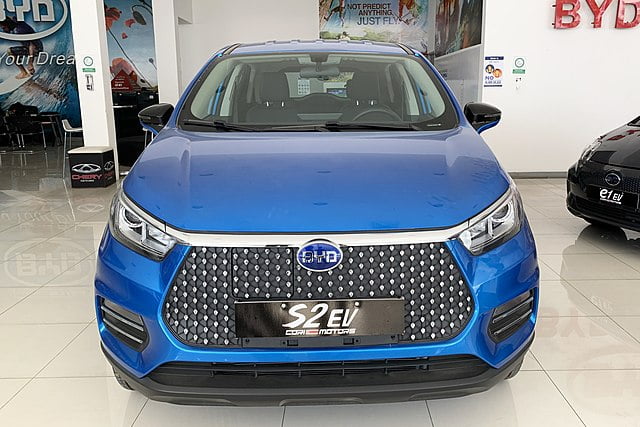Chinese electric car manufacturer BYD has emerged as a strong competitor to Tesla. The company’s shares have surged after it announced that it expects its third-quarter profits to more than double compared to last year. BYD is now producing more cars per quarter than Tesla and is second only to the US car maker in global sales. This success highlights the rapid growth of China’s auto industry, which has surpassed Japan to become the world’s largest exporter. However, tensions between China and other countries, particularly the US and EU, may pose challenges for the export market of Chinese electric vehicles.
BYD had an advantage from the beginning, as it started as a battery company before expanding into car manufacturing. Its CEO, Wang Chuanfu, grew up in a poor province in China and co-founded BYD in 1995. The company gained recognition for its rechargeable batteries, which competed with expensive Japanese imports. In 2002, BYD became a publicly traded company and later diversified by acquiring a struggling state-owned car manufacturer. The Chinese government introduced subsidies and tax breaks to promote renewable energy production, creating a favorable market for BYD’s batteries to power electric vehicles.
BYD’s success can be attributed to its in-house battery production, which saves the company money as batteries are one of the most expensive components of an electric vehicle. Competitors like Tesla rely on third-party manufacturers for batteries. According to a UBS report, BYD’s entry-level electric vehicle, the Seagull, has a 15% price advantage over Tesla’s Chinese-made base Model 3 sedan. This affordability has contributed to BYD’s popularity, as it surpassed Germany’s Volkswagen to become China’s top-selling car brand.
While Tesla is credited with popularizing electric vehicles in China, BYD has outperformed it in terms of sales. Tesla’s sales of Chinese-made electric vehicles dropped by almost 11% in September, while BYD experienced a 43% increase in sales during the same period. However, Tesla remains a favorite brand among younger buyers in China. As tensions between the US and China escalate, Tesla is also exploring opportunities in India as an alternative market.
The future of the electric vehicle market looks promising, with analysts predicting a significant shift towards green incentives by 2030. European and UK car manufacturers are struggling to compete, and concerns about China’s dominance may lead to regulations that limit the access of Chinese car makers to the European market. The European Commission is currently investigating the possibility of setting tariffs to protect EU manufacturers from cheaper Chinese electric vehicles. Despite these challenges, BYD’s affordable and environmentally friendly cars are gaining popularity globally, particularly in Germany, where high inflation and energy costs are driving demand for affordable options.
Original news source: BYD: The top electric car maker that is not Tesla (BBC)
Listen
Slow
Normal
Fast
Group or Classroom Activities
Warm-up Activities:
– Charades
Instructions: Divide the class into two teams. Each team will take turns acting out words or phrases related to the article. One member from each team will come to the front of the class and act out the word or phrase silently, while their team members try to guess what it is. The team with the most correct guesses wins.
– News Summary
Instructions: In pairs or small groups, students will take turns summarizing the main points of the article. They should focus on the key information and try to condense it into a brief summary. After each summary, the other students can provide feedback and ask questions to clarify any confusion.
– Opinion Poll
Instructions: Students will write down their opinions on a specific question related to the article, such as “Do you think BYD will continue to outperform Tesla in the electric vehicle market?” or “Should the EU set tariffs on Chinese electric vehicles?” They will then walk around the class and ask their classmates for their opinions, noting down their responses. Afterward, they can share the results and discuss the different perspectives.
– Pros and Cons
Instructions: Divide the class into two groups. One group will brainstorm the pros of BYD’s success and the growth of China’s auto industry, while the other group will brainstorm the cons. Each group will then present their ideas to the class, and the other group can add any additional points they think of. The class can then have a discussion, weighing the pros and cons and considering the potential future implications.
– Future Predictions
Instructions: In pairs or small groups, students will discuss and make predictions about the future of the electric vehicle market. They should consider factors such as government regulations, technological advancements, and consumer preferences. Each group will present their predictions to the class, explaining their reasoning and any evidence they have to support their ideas. The class can then discuss and compare the different predictions.
Comprehension Questions:
1. How has BYD emerged as a strong competitor to Tesla?
2. What advantage did BYD have from the beginning?
3. How did the Chinese government support BYD’s growth in the renewable energy market?
4. What is one factor that has contributed to BYD’s popularity over Tesla in China?
5. How have Tesla’s sales of Chinese-made electric vehicles compared to BYD’s sales?
6. What alternative market is Tesla exploring due to escalating tensions between the US and China?
7. What are analysts predicting for the future of the electric vehicle market?
8. Why are BYD’s affordable cars gaining popularity in Germany?
Go to answers ⇩
Listen and Fill in the Gaps:
Chinese electric car manufacturer BYD has emerged as a strong competitor to Tesla. The company’s shares have surged after it announced that it expects its third-quarter profits to more than double compared to last year. BYD is now producing more cars per quarter than Tesla and is second only to the US car maker in (1)______ sales. This success highlights the rapid growth of China’s auto industry, which has surpassed Japan to become the world’s largest exporter. However, tensions between China and other countries, particularly the US and EU, may pose (2)______ for the export market of Chinese electric (3)______.
BYD had an advantage from the beginning, as it started as a (4)______ company before expanding into car manufacturing. Its CEO, Wang Chuanfu, grew up in a poor province in China and co-founded BYD in 1995. The company gained recognition for its (5)______ batteries, which competed with expensive Japanese imports. In 2002, BYD (6)______ a publicly traded company and later diversified by acquiring a struggling state-owned car manufacturer. The Chinese (7)______ introduced subsidies and tax breaks to promote renewable energy production, (8)______ a favorable market for BYD’s batteries to power electric vehicles.
BYD’s success can be attributed to its in-house battery production, which saves the company money as batteries are one of the most expensive components of an electric vehicle. Competitors like Tesla rely on third-party manufacturers for batteries. (9)______ to a UBS report, BYD’s entry-level electric vehicle, the Seagull, has a 15% price advantage over Tesla’s Chinese-made base Model 3 (10)______. This affordability has contributed to BYD’s popularity, as it surpassed Germany’s Volkswagen to (11)______ China’s top-selling car brand.
While Tesla is credited with popularizing electric vehicles in China, BYD has outperformed it in terms of sales. Tesla’s sales of Chinese-made electric vehicles dropped by almost 11% in September, while BYD experienced a 43% increase in sales during the same period. However, Tesla (12)______ a favorite brand among younger buyers in China. As tensions between the US and China escalate, Tesla is also exploring opportunities in India as an alternative market.
The future of the electric vehicle market looks promising, with analysts predicting a significant shift towards green incentives by 2030. European and UK car manufacturers are (13)______ to (14)______, and concerns about China’s dominance may lead to regulations that limit the access of Chinese car makers to the European market. The European Commission is currently (15)______ the possibility of setting tariffs to protect EU manufacturers from cheaper Chinese electric vehicles. Despite these challenges, BYD’s (16)______ and environmentally friendly cars are gaining popularity globally, particularly in Germany, where high inflation and energy costs are driving demand for affordable options.
Go to answers ⇩
Discussion Questions:
Students can ask a partner these questions, or discuss them as a group.
1. What is BYD and how has it become a strong competitor to Tesla?
2. How would you feel if you owned a Chinese-made electric vehicle and tensions between China and other countries affected the export market?
3. Do you like the idea of electric vehicles becoming more popular? Why or why not?
4. Do you think BYD’s success is mainly due to its in-house battery production? Why or why not?
5. How would you feel if you were a European or UK car manufacturer struggling to compete with Chinese electric vehicles?
6. What is the future of the electric vehicle market predicted to be like? Do you think these predictions will come true? Why or why not?
7. How would you feel if your country implemented green incentives to encourage the use of electric vehicles?
8. Do you think it’s fair for the European Commission to consider setting tariffs to protect EU manufacturers from cheaper Chinese electric vehicles? Why or why not?
9. What is the appeal of BYD’s affordable and environmentally friendly cars? Why do you think they are gaining popularity globally?
10. How would you feel if you were a younger buyer in China and Tesla’s sales dropped while BYD’s sales increased?
11. What is your opinion on the rapid growth of China’s auto industry surpassing Japan to become the world’s largest exporter?
12. How would you feel if you were a car manufacturer relying on third-party manufacturers for batteries, like Tesla?
13. Do you think the tensions between the US and China will have a significant impact on the electric vehicle market? Why or why not?
14. How would you feel if your country implemented regulations to limit the access of Chinese car makers to the market?
15. What is your opinion on the shift towards green incentives by 2030? Do you think it will be successful? Why or why not?
Individual Activities
Vocabulary Meanings:
Match each word to its meaning.
Words:
1. BYD
2. Tesla
3. China
4. electric
5. batteries
6. sales
7. market
8. affordable
Meanings:
(a) US car maker and competitor to BYD
(b) The industry in which BYD and Tesla compete
(c) The country where BYD and Tesla are based
(d) Expensive components of an electric vehicle
(e) Powered by electricity
(f) Reason for BYD’s popularity and success
(g) Number of cars sold
(h) Chinese electric car manufacturer
Go to answers ⇩
Multiple Choice Questions:
1. What has BYD announced about its third-quarter profits?
(a) They are expected to decrease compared to last year.
(b) They are expected to more than double compared to last year.
(c) They are expected to remain the same as last year.
(d) They are expected to decrease by half compared to last year.
2. Which company is producing more cars per quarter than Tesla?
(a) BYD
(b) Volkswagen
(c) Toyota
(d) BMW
3. What has China’s auto industry surpassed to become the world’s largest exporter?
(a) Germany
(b) United States
(c) Japan
(d) South Korea
4. What advantage did BYD have from the beginning?
(a) It had a strong partnership with Tesla.
(b) It had access to cheap labor.
(c) It received government subsidies.
(d) It started as a battery company before expanding into car manufacturing.
5. What is one of the most expensive components of an electric vehicle?
(a) Batteries
(b) Tires
(c) Seats
(d) Windows
6. According to a UBS report, which BYD electric vehicle has a price advantage over Tesla’s Chinese-made base Model 3 sedan?
(a) Dolphin
(b) Eagle
(c) Falcon
(d) Seagull
7. How did Tesla’s sales of Chinese-made electric vehicles perform in September?
(a) They increased by 43%.
(b) They dropped by almost 11%.
(c) They remained the same as the previous month.
(d) They doubled compared to the previous month.
8. What are analysts predicting for the electric vehicle market by 2030?
(a) A decrease in demand for electric vehicles.
(b) A decrease in government support for electric vehicles.
(c) A significant shift towards green incentives.
(d) A shift towards traditional gasoline-powered vehicles.
Go to answers ⇩
True or False Questions:
1. BYD’s success is not attributed to its in-house battery production, which saves the company money.
2. BYD’s affordability has not contributed to its popularity, surpassing Germany’s Volkswagen to become China’s top-selling car brand.
3. BYD started as a battery company before expanding into car manufacturing.
4. China’s auto industry has surpassed Japan to become the world’s largest exporter.
5. BYD does not expect its third-quarter profits to more than double compared to last year.
6. The export market of Chinese electric vehicles may not face challenges due to tensions between China and other countries, particularly the US and EU.
7. BYD, a Chinese electric car manufacturer, is emerging as a strong competitor to Tesla.
8. BYD is producing more cars per quarter than Tesla and is second only to Tesla in global sales.
Go to answers ⇩
Write a Summary:
Write a summary of this news article in two sentences.
Check your writing now with the best free AI for English writing!
Writing Questions:
Answer the following questions. Write as much as you can for each answer.
Check your answers with our free English writing assistant!
1. How has BYD emerged as a strong competitor to Tesla?
2. What advantages did BYD have from the beginning that contributed to its success?
3. How does BYD’s in-house battery production give it a competitive edge over Tesla?
4. How have BYD’s sales compared to Tesla’s in China?
5. What challenges does BYD face in terms of accessing the European market?
Answers
Comprehension Question Answers:
1. How has BYD emerged as a strong competitor to Tesla?
BYD has emerged as a strong competitor to Tesla by producing more cars per quarter than Tesla and being second only to Tesla in global sales.
2. What advantage did BYD have from the beginning?
BYD had the advantage of starting as a battery company before expanding into car manufacturing. Its in-house battery production saves the company money as batteries are one of the most expensive components of an electric vehicle.
3. How did the Chinese government support BYD’s growth in the renewable energy market?
The Chinese government introduced subsidies and tax breaks to promote renewable energy production, creating a favorable market for BYD’s batteries to power electric vehicles.
4. What is one factor that has contributed to BYD’s popularity over Tesla in China?
One factor that has contributed to BYD’s popularity over Tesla in China is the affordability of its electric vehicles. According to a UBS report, BYD’s entry-level electric vehicle has a 15% price advantage over Tesla’s Chinese-made base Model 3 sedan.
5. How have Tesla’s sales of Chinese-made electric vehicles compared to BYD’s sales?
Tesla’s sales of Chinese-made electric vehicles dropped by almost 11% in September, while BYD experienced a 43% increase in sales during the same period.
6. What alternative market is Tesla exploring due to escalating tensions between the US and China?
Due to escalating tensions between the US and China, Tesla is exploring opportunities in India as an alternative market.
7. What are analysts predicting for the future of the electric vehicle market?
Analysts are predicting a significant shift towards green incentives in the electric vehicle market by 2030.
8. Why are BYD’s affordable cars gaining popularity in Germany?
BYD’s affordable cars are gaining popularity in Germany due to high inflation and energy costs, which are driving demand for affordable options.
Go back to questions ⇧
Listen and Fill in the Gaps Answers:
(1) global
(2) challenges
(3) vehicles
(4) battery
(5) rechargeable
(6) became
(7) government
(8) creating
(9) According
(10) sedan
(11) become
(12) remains
(13) struggling
(14) compete
(15) investigating
(16) affordable
Go back to questions ⇧
Vocabulary Meanings Answers:
1. BYD
Answer: (h) Chinese electric car manufacturer
2. Tesla
Answer: (a) US car maker and competitor to BYD
3. China
Answer: (c) The country where BYD and Tesla are based
4. electric
Answer: (e) Powered by electricity
5. batteries
Answer: (d) Expensive components of an electric vehicle
6. sales
Answer: (g) Number of cars sold
7. market
Answer: (b) The industry in which BYD and Tesla compete
8. affordable
Answer: (f) Reason for BYD’s popularity and success
Go back to questions ⇧
Multiple Choice Answers:
1. What has BYD announced about its third-quarter profits?
Answer: (b) They are expected to more than double compared to last year.
2. Which company is producing more cars per quarter than Tesla?
Answer: (a) BYD
3. What has China’s auto industry surpassed to become the world’s largest exporter?
Answer: (c) Japan
4. What advantage did BYD have from the beginning?
Answer: (d) It started as a battery company before expanding into car manufacturing.
5. What is one of the most expensive components of an electric vehicle?
Answer: (a) Batteries
6. According to a UBS report, which BYD electric vehicle has a price advantage over Tesla’s Chinese-made base Model 3 sedan?
Answer: (d) Seagull
7. How did Tesla’s sales of Chinese-made electric vehicles perform in September?
Answer: (b) They dropped by almost 11%.
8. What are analysts predicting for the electric vehicle market by 2030?
Answer: (c) A significant shift towards green incentives.
Go back to questions ⇧
True or False Answers:
1. BYD’s success is not attributed to its in-house battery production, which saves the company money. (Answer: False)
2. BYD’s affordability has not contributed to its popularity, surpassing Germany’s Volkswagen to become China’s top-selling car brand. (Answer: False)
3. BYD started as a battery company before expanding into car manufacturing. (Answer: True)
4. China’s auto industry has surpassed Japan to become the world’s largest exporter. (Answer: True)
5. BYD does not expect its third-quarter profits to more than double compared to last year. (Answer: False)
6. The export market of Chinese electric vehicles may not face challenges due to tensions between China and other countries, particularly the US and EU. (Answer: False)
7. BYD, a Chinese electric car manufacturer, is emerging as a strong competitor to Tesla. (Answer: True)
8. BYD is producing more cars per quarter than Tesla and is second only to Tesla in global sales. (Answer: True)
Go back to questions ⇧













